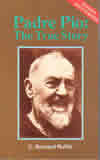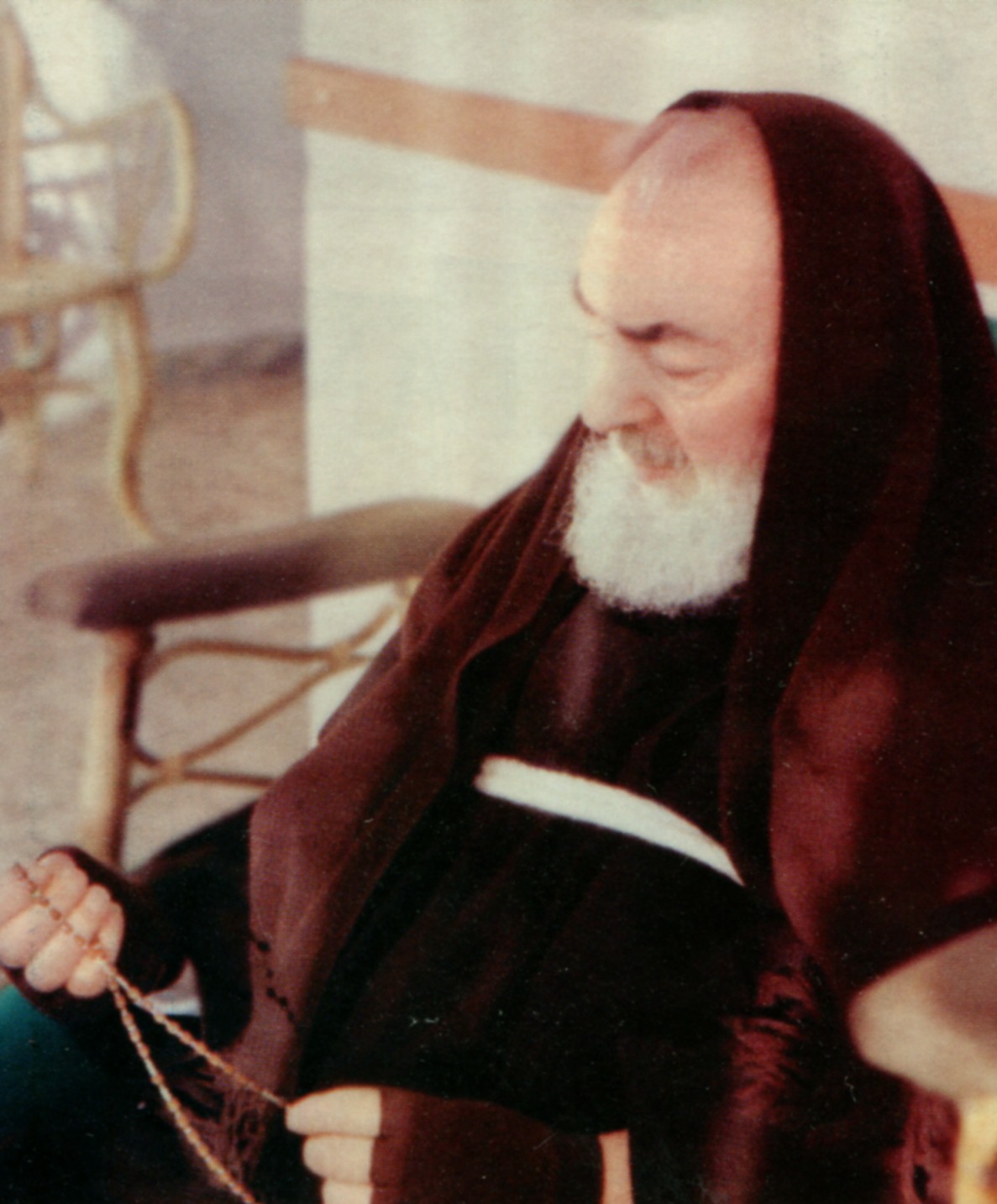 Padre
Pio: The True Story By C. Bernard Ruffin,
The most factual book ever written on the greatest mystic since St. Francis of
Assisi, with unforgettable photographs (16 pages) and new material! Watch the
remarkable miracles come to life with hard facts. Updated version. Must-have for
any mystical library!
click here
Padre
Pio: The True Story By C. Bernard Ruffin,
The most factual book ever written on the greatest mystic since St. Francis of
Assisi, with unforgettable photographs (16 pages) and new material! Watch the
remarkable miracles come to life with hard facts. Updated version. Must-have for
any mystical library!
click here
Spirit
Daily
__________________________________________
From the archives:
Saint Padre Pio
Was Study In Most Inexplicable Of Gifts: Bilocation
By Michael H. Brown
Saint Padre Pio of
Pietrelcina was known for many phenomena, none more
mysterious than his seeming ability to appear in two places simultaneously.
This is called "bilocation,"
and it's a mystical gift that is truly unfathomable. How can a physical object
-- the body -- be in two separate locations? Is it the person's spirit they see
-- the "prolongation" of a personality? Or is it simply
an angel manifesting in the visage of the person who sent him?
These are questions that,
at least for now, must go unanswered.
What we can say is that it's
a phenomenon that has been reported with saints such as Anthony of Padua and
Alphonsus Liguori. More recently, we have spoken with witnesses who have
testified to the bilocations of Maria Esperanza, the great Venezuelan mystic.
With Padre Pio
the examples were extraordinary.
He was seen by a man lost on the Sahara desert who was then led to safety by the
mysterious stranger (after this man's mother had sought Padre Pio's aid). He was
witnessed, or so they say, in the U.S., in Hawaii. He was reported in
Siberia.
There are those, including bishops, who say he was spotted at the Vatican
itself (appearing to Pope Pius XI during a crisis moment, when an archbishop
was trying to defrock him),
and also at the
canonization of St. Therese the Little Flower in 1925.
"It is well
to note that from 1918 onward, Padre Pio never left San Giovanni Rotundo, so
that these mysterious occurrences cannot be explained through the assumption
that Padre Pio was actually there in person," notes biographer Bernard Ruffin,
who wrote a classic history of the
astonishing Franciscan -- around whom swirled more mysticism than anyone since
St. Francis of Assisi. There was even physical evidence of his
manifestations. Such occurred in 1957, when Pio appeared at the bedside of
another priest, Padre Placido Bux, who was hospitalized with severe hepatic
cirrhosis.
 "One night
Padre Placido saw Padre Pio next to his bed, and he spoke to him, exhorting him
to have patience, comforting him and reassuring him of his recovery," wrote
another biographer, Padre Alberto D'Apolito, who knew Padre Pio. "Then he saw
Padre Pio approach the window of the [hospital] room, place a hand on the
glass, and disappear. On awakening in the morning, he felt better and
remembering the very welcome visit, he looked towards the window. To his
surprise, he saw the imprint of a hand on the window. He got up from bed and
approached the window to closely examine and identify the print: he recognized
the imprint of the hand of Padre Pio."
"One night
Padre Placido saw Padre Pio next to his bed, and he spoke to him, exhorting him
to have patience, comforting him and reassuring him of his recovery," wrote
another biographer, Padre Alberto D'Apolito, who knew Padre Pio. "Then he saw
Padre Pio approach the window of the [hospital] room, place a hand on the
glass, and disappear. On awakening in the morning, he felt better and
remembering the very welcome visit, he looked towards the window. To his
surprise, he saw the imprint of a hand on the window. He got up from bed and
approached the window to closely examine and identify the print: he recognized
the imprint of the hand of Padre Pio."
More
incredibly, when personnel attempted to clean the window with a wet cloth dipped
in detergent,
"the imprint
always reappeared."
During his
bilocations, Pio was often seen in a nearly comatose state. Such was the case in
1953 when the priest, joining other monks for a concert in an adjoining hall,
"placed his arms on the back of the chair in front of him and rested his head on
them, remaining silent and motionless," according to another witness, Padre
Carmelo of Sessano. This occurred for a period of about five minutes, then Padre
Pio rejoined the group.
"The next day,
Padre Carmelo went to visit a sick man and was amazed when [the sick man]
expressed his
appreciation for
permitting Padre Pio to call on him the previous evening," writes Ruffin. "Carmelo,
of course, knew very well that Padre Pio was at the concert all evening and had
gone straight to the friary when it was over."
In yet another
case, Monsignor Fernando Damiani, vicar of Salto, Uruguay, asked for Padre Pio's
help with such a severe coronary condition that he had come to Italy to die near
the famous monk. Pio told him he was not yet ready to die and that, when it was
his time, it would be in his homeland of Uruguay. Furthermore, said Pio, "I
promise to see to it that you are well assisted spiritually."
In 1941,
during a congress on vocations that had brought several bishops to Salto, one of
them, Archbishop Maria Barbieri of Montevideo, was retiring in his room when he
heard a strange knock on his door. The hall was dark but there he saw the form
of a Capuchin monk -- who told him to go see Monsignor Damiani because Damiani
was dying.
Archishop
Barbieri did just that and found Damiani writhing in pain and dying. Barbieri
administered last rites while three other bishops and six priests rushed to the
scene -- such that Damiani was surrounded by a total of four bishops and six
other priests when he expired --
the "help" Pio
had promised!
Several
witnesses claimed that they saw Padre Pio at the tomb of St. Pius X. In fact he
was seen in the crypt on at least five occasions. During the beatification of
St. Therese the Little Flower, a prelate went to approach him when he "saw" the
monk in St. Peter's Basilica --
but as he got
close, Padre Pio vanished.
"Externally,
the condition of Padre Pio's ecstasy was the same as though he were asleep,"
wrote Father Charles Mortimer Carty, another biographer. "The members of his
body were numb to all external influences." Pio himself was the one who
described bilocation as a "prolongation" or "extension" of his personality. "I
only know that it is God Who sends me," replied Padre Pio when questioned about
it. "I do
not know whether I am there with my soul or body, or both of them."
In one
case, a pious young girl of 14 named Emma Meneghello, who suffered epilepsy,
testified that while in prayer Padre Pio appeared to her, placed his hand on her
bed sheet, smiled, and vanished. The cured girl then arose to kiss the place
where Pio had placed his hand and noticed
a cross of blood
on the sheet (this stain has been preserved).
Perhaps most
remarkable was the testimony of a woman named Madre Speranza who worked at the
Vatican and claimed to have seen Pio in Rome on a number of occasions.
"I saw him in the Holy Office every day for an entire year," she testified. "He
wore half-gloves to conceal his wounds. I would greet him, kiss his hand, and
sometimes, I would speak to him and he would reply."
At the same
time (1937 to 1939), Meneghello claimed to have encountered "a mysterious
personage with a white beard who would arrive from Milan by plane; he was ugly
and made me tremble with fear. Just the sight of him would fill me with great
fear, and I wanted to escape. He seemed to me to be the devil."
What was he
doing at the Holy Office?
"He went to
testify against Padre Pio," said the holy woman -- this at a time when Padre Pio
was under much persecution.
Such
attempts, of course, failed -- and so one of history greatest and most
mysterious men will become St. Pio on Sunday.
Father D'Apolito said even Padre Pio didn't understand the phenomena that surrounded
him. "I
recognize,"
he quoted the
monk as saying,
"that I am a mystery to myself."
"Under
whatever aspect I observed or studied him," added D'Apolito, "I was more and
more convinced that I understood nothing about him."
Return to Spiritdaily.com
 Padre
Pio: The True Story By C. Bernard Ruffin,
The most factual book ever written on the greatest mystic since St. Francis of
Assisi, with unforgettable photographs (16 pages) and new material! Watch the
remarkable miracles come to life with hard facts. Updated version. Must-have for
any mystical library!
click here
Padre
Pio: The True Story By C. Bernard Ruffin,
The most factual book ever written on the greatest mystic since St. Francis of
Assisi, with unforgettable photographs (16 pages) and new material! Watch the
remarkable miracles come to life with hard facts. Updated version. Must-have for
any mystical library!
click here